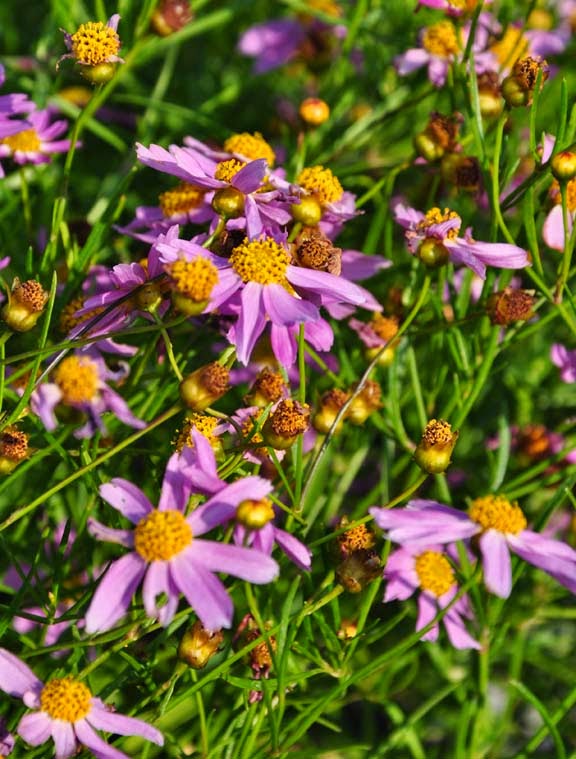A container planting with a lime colored Coleus and Butterfly Gaura, Gaura lindheimeri
My Dad dressed in his maroon swimming trunks; a grey sweatshirt wrapped over his shoulders leans on a black cane with one hand and on my arm with the other. He is a small man, but his weight on my arm is considerable as we navigate the rough gravel path that leads down to the lakefront beach.
I had asked my Mom, as we made dinner together the night I arrived, what my eighty-seven year old Dad would most like to do while my sister Nancy and I were at home.
"He wants to go swimming," she told me.
Humble Lobelia in a metal bucket.
Our week-long visit has flown by and it is the final couple of days before my sister and I must fly back to our regular adult lives on different continents. The weather has turned overcast and a bit blustery, but we are both determined to honour Dad's wish to go for a summer swim.
Odd boulders and serpentine tree roots mean that every step my Dad and I take down the forested pathway to the lake is a new adventure for Dad and his cane. We pause frequently, so he can catch his breath.
When we finally reach the beach the lake is looking black and mighty cold. The two life guards in attendance are wearing jackets over their swimsuits. Unfazed, my Dad takes my sister's arm, and with his cane in the other hand, he heads into the water. As my Mom and I watch anxiously from the shore, there are a few tense moments when he falters on the sand, but Dad recovers his balance and strides out into the dark water.
Chest deep he throws the cane back to us on shore and he and Nancy take the plunge.
Burr that's got to be cold!
But as I look at my Dad's face as it pops up out of the water, he looks only happy. While he struggles to be mobile on land, he is buoyant in the water. Jubilation is written all over his face.
That moment of sheer joy will most certainly be one of my dearest memories of my trip home to Nova Scotia.
Jacquie's Garden
There are lots of other wonderful memories too.
Though there was little time to visit local gardens, Mom took me to visit her friend Jacquie's garden the afternoon I arrived.
Martagon lilies.
My favourite object in Jacquie's garden: a carving of a hand with long tapered fingers. The hand rests on an old wooden bench. One day I must ask her about the story behind the hand.
This is Valentine.
As you can by her dark stare, Valentine eyed me with suspicion the whole time we were in Jacquie's garden.
My Mom, on the other hand, she adored. Though Valentine notoriously dislikes visitors, she put her tiny paws up on my Mom's trouser legs and begged repeatedly to be petted.
I am sure she would have nipped my hand if I had dared to do the same! So much for the notion I hold any sway with dogs!
Mahone Bay
Almost everywhere I went on my trip to Nova Scotia, there seemed to be flowers.
Liatris with pink Phlox paniculata in the background.
Blazing Star or Gayfeather, Liatris spicata: forms a low clump of grass-like foliage with flowers spikes of magenta-purple, white or flowers in late summer. Attractive to butterflies and bees. Full sun. Height: 75-90 cm, Spread: 30-45 cm. Laitris will grow in a variety of soil types and are pretty drought tolerant once established.
Honeysuckle Vine
Mahone Bay
Houses in Nova Scotia are sometimes painted the most outrageous colors.
I had to pull the car to the side of the road and take this picture.
Orange Tiger Lilies en masse.
My sisters and I (a third sister lives in Dartmouth, N.S.) did the most touristy thing we could possibly do: we went on a little mini-vacation that took us along the South Shore to Peggy's Cove and Mahone Bay. We avoided the main highway and opted instead for old twisty-turny road along shores of the Atlantic ocean.
The land that hugs the St. Margaret's Bay is a lunar landscape of granite boulders and plants that manage to cling to life in thin soil, salt air and harsh winds.
When you reach Peggy's Cove, the vista becomes a mix of rolling hills of stone and little salt water ponds.
The white lighthouse at Peggy's Cove is one of Nova Scotia's most famous landmarks.
Do you see the figure on the lower right?
This lady, with her wide brimmed hat and accordion, was singing traditional ballads
for all the visiting tourists.
My sisters and I stayed overnight in this resort hotel.
We had our evening meal on the terrace and watched the sun go down. Dinner was delicious! I had roast chicken, while both my sisters enjoyed pan-seared halibut with scollops and shrimps in a lobster-cream sauce.
I flew home on the weekend with a bit of a heavy heart. How I wish I lived closer so I could check in on my parents more often! They need help, even though they are reluctant to accept it.
When I got home this big bouquet of dahlias awaited me on the kitchen counter. It was a wonderful trip, but it is always nice to come back home.


























































